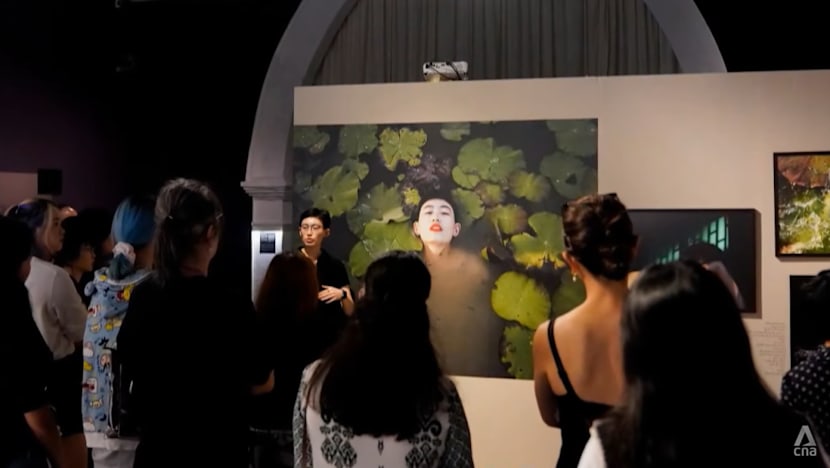Singapore art groups look overseas to grow global presence, develop talent
Rising costs remain a challenge, however, with travel and shipping expenses increasing by about a third in recent years.

A tour at Objectifs, a visual arts centre for photography and film located in Bugis, Singapore.

This audio is generated by an AI tool.
SINGAPORE: Singapore’s art scene is expanding its footprint overseas, with some local galleries and art spaces doubling their international engagements since the COVID-19 pandemic.
The push to go abroad aims to develop talent, reach wider audiences and introduce a more diverse range of artworks to the local scene.
Major institutions like the National Gallery Singapore, where footfall last year managed to exceed pre-pandemic levels, are also deepening their global connections.
BUILDING CONNECTIONS
At independent contemporary art gallery Yeo Workshop, international exposure has become a key part of its mission.
The gallery has doubled its participation at overseas art fairs since 2019, joining events in Paris, Hong Kong and South Korea. Some of these connections have led to invitations to larger shows such as biennales.
For founder Audrey Yeo, these international opportunities are crucial for artists’ development.
“It's very important that local artists have their work seen by an international arena, because you meet all the cream of the crop of curators, institutions, museums and art collectors at these platforms,” said Ms Yeo, who is also the president of the Art Galleries Association, Singapore.
“When our local artists get an opportunity to exhibit there, they then (can) interact with those audiences and level up their practice to the next level … When they come home, the community can appreciate or benefit from their artwork,” she added.
Some of these artists’ works have been shown at free public exhibitions or donated to medical institutions such as the Institute of Mental Health.
At Objectifs, a visual arts centre for photography and film located in Bugis, regional collaborations have also been on the rise.
Interest from international artists to collaborate and exhibit at Objectifs has grown by around 20 per cent since the pandemic.
The space has hosted artists from around Southeast Asia for mentorships, and conducts tours for students and seniors to engage with regional art.
Programme director Chelsea Chua said such initiatives help build empathy and a sense of community.
"I think that (the onus) is also on art spaces like us to create different points of engagement for different communities and different audiences … to expand one's worldview, to form different kinds of solidarities, to learn about lived experience outside our own,” she added.
RISING COSTS
Still, industry players said rising costs remain a challenge, with travel and shipping expenses increasing by about a third in recent years.
Local grants and platforms like the Singapore Biennale, however, have helped ease the burden.
The event, organised by the Singapore Art Museum (SAM), brings together artists from around the world for dialogues and exhibitions.
“Often, these conversations also lead to collaborations in the future beyond the Biennale,” said SAM chief curator Shabbir Hussain Mustafa.
“This is also what we're trying to develop - allow our artists to develop the right kind of networks so that they can go on to build projects well beyond SAM and its initiatives.”
She added that the museum is dedicated to inviting local artists to participate in these conversations, as well as reaching out to young and emerging artists to help take their work further.

The National Arts Council (NAC) is also playing its part through international exchange programmes.
Four Singaporean artists will be heading to South Korea later this year under a partnership with the Korean Foundation for International Cultural Exchange.
Mr Sam Lay, director of strategic partnerships and engagement at NAC, said the collaboration aims to deepen understanding between the two countries’ art sectors.
The artists will be researching venues and the sustainability of the respective art markets, he added.
Findings from the initiative will be used to start future programmes with other international partners. NAC said it will continue to foster exchanges that support local art makers.
“I think we intend to use arts and culture as a very meaningful way to strengthen the relationship between countries,” Mr Lay added.
ENGAGING YOUNG AUDIENCES
At home, the National Gallery Singapore has seen record-breaking growth a decade after its opening.
The museum now attracts nearly 2 million visitors a year – nearly triple its opening-year tally. It credits its expanded Singapore-Southeast Asia programmes and easier public access for the surge.
From blockbuster festivals like Light to Night to smaller community-focused initiatives, CEO Eugene Tan said the Gallery strives to be a space for everyone.
“This has really been our fundamental base from which we've then used to foster a greater appreciation of art among our public, both in Singapore and Southeast Asia,” he told CNA.
A key focus of the Gallery now is engaging youth audiences – a challenge faced by many museums worldwide, said Dr Tan.
The Gallery has put in place initiatives like the Kolektif – its flagship youth programme for 17- to 25-year-olds, who are provided a platform to speak up on issues.
“We also use social media a lot. For example, a post that we did using Gen Z language slang reached over 9 million viewers, and this also helps to bring younger audiences to the gallery … because the youths are really the future of our society,” Dr Tan added.
Experts said museums like the Gallery can double up as spaces to build communities, especially for the youth, through forums and conversations.
"The youth are bringing their concerns, but also their creativity and criticality into the museums,” said Dr Priya Jaradi, senior lecturer and convenor of art history at the National University of Singapore.
“These are very important to give our youth a sense of participation and agency, so that they do feel that they are co-writing the next chapter – whether of art museums or framing our identity as Singaporeans.”



















